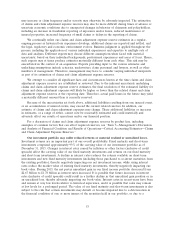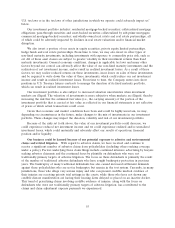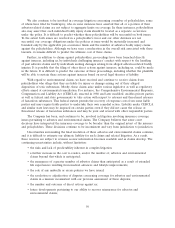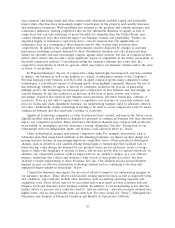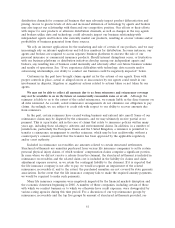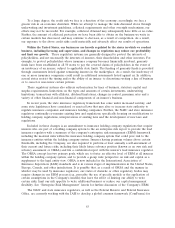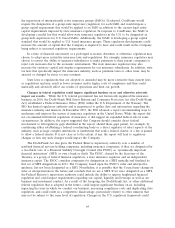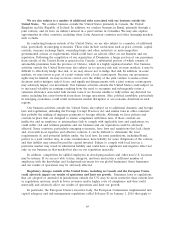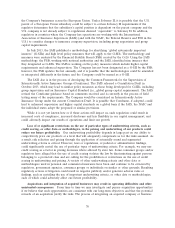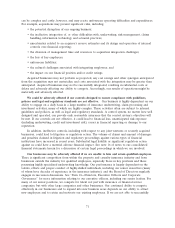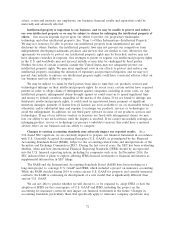Travelers 2015 Annual Report Download - page 63
Download and view the complete annual report
Please find page 63 of the 2015 Travelers annual report below. You can navigate through the pages in the report by either clicking on the pages listed below, or by using the keyword search tool below to find specific information within the annual report.To a large degree, the credit risk we face is a function of the economy; accordingly, we face a
greater risk in an economic downturn. While we attempt to manage the risks discussed above through
underwriting and investment guidelines, collateral requirements and other oversight mechanisms, our
efforts may not be successful. For example, collateral obtained may subsequently have little or no value.
Further, the amount of collateral protection we have been able to obtain on the business we write in
certain markets has decreased, and may continue to decrease, as a result of competition. As a result,
our exposure to the above credit risks could materially and adversely affect our results of operations.
Within the United States, our businesses are heavily regulated by the states in which we conduct
business, including licensing and supervision, and changes in regulation may reduce our profitability
and limit our growth. These regulatory systems are generally designed to protect the interests of
policyholders, and not necessarily the interests of insurers, their shareholders and other investors. For
example, to protect policyholders whose insurance company becomes financially insolvent, guaranty
funds have been established in all 50 states to pay the covered claims of policyholders in the event of
an insolvency of an insurer, subject to applicable state limits. The funding of guaranty funds is provided
through assessments levied against remaining insurers in the marketplace. As a result, the insolvency of
one or more insurance companies could result in additional assessments levied against us. In addition,
several states restrict the timing and/or the ability of an insurer to discontinue writing a line of business
or to cancel or non-renew certain policies.
These regulatory systems also address authorization for lines of business, statutory capital and
surplus requirements, limitations on the types and amounts of certain investments, underwriting
limitations, transactions with affiliates, dividend limitations, changes in control, premium rates and a
variety of other financial and non-financial components of an insurer’s business.
In recent years, the state insurance regulatory framework has come under increased scrutiny, and
some state legislatures have considered or enacted laws that may alter or increase state authority to
regulate insurance companies and insurance holding companies. Further, the NAIC and state insurance
regulators continually re-examine existing laws and regulations, specifically focusing on modifications to
holding company regulations, interpretations of existing laws and the development of new laws and
regulations.
Included in these changes is an amendment to insurance holding company regulations that require
insurers who are part of a holding company system to file an enterprise risk report to provide the lead
insurance regulator with a summary of the company’s enterprise risk management (ERM) framework
including the material risks within the insurance holding company system that could pose risk to the
insurance entities within the holding company system. Insurers having premium volume above certain
thresholds, including the Company, are also required to perform at least annually a self-assessment of
their current and future risks, including their likely future solvency position (known as an own risk and
solvency assessment or ORSA) and file a confidential report with the insurer’s lead insurance regulator.
The ORSA concept has two primary goals, which are to foster an effective level of ERM at all insurers
within the holding company system, and to provide a group wide perspective on risk and capital as a
supplement to the legal entity view. ORSA is now included in the International Association of
Insurance Supervisors (IAIS) standards and is in various stages of implementation in the United States,
Europe, Canada, and other jurisdictions. It is possible that, as a result of ORSA and the manner in
which it may be used by insurance regulators, our states of domicile or other regulatory bodies may
require changes in our ERM process (e.g., prescribe the use of specific models or the application of
certain assumptions in the Company’s models) that have the effect of limiting our ability to write
certain risks, limit our risk appetite to write additional business or reduce our capital management
flexibility. See ‘‘Enterprise Risk Management’’ herein for further discussion of the Company’s ERM.
The NAIC and state insurance regulators, as well as the Federal Reserve and Federal Insurance
Office, are currently working with the IAIS to develop a global common framework (ComFrame) for
63


